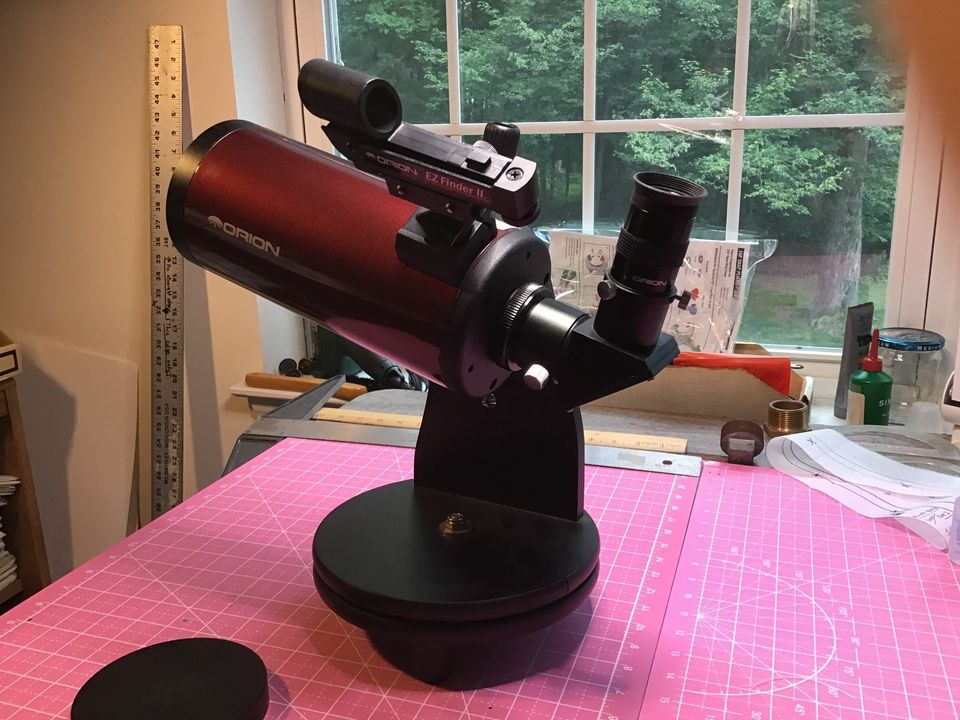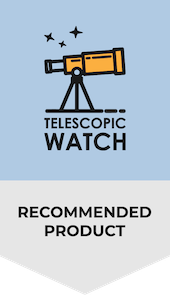The Optical Tube Of Starmax 90mm
The StarMax 90 OTA is identical to Celestron’s C90 optical tube; a 90mm f/13.9 Maksutov-Cassegrain – the only difference being its attractive ruby-red powder coated finish, and a red-dot finder instead of the cheap straight-through finderscope supplied with the C90.

The StarMax 90 has 3 Allen head collimation screws which can be used to collimate the scope if need be, though Maksutov-Cassegrains rarely, if ever, fall out of collimation. I’ve actually dropped a 90mm Mak a few feet onto the ground by accident and the collimation remained fine. This is certainly a testament to the build quality of these fine telescopes.
Like many telescopes, the StarMax 90 optical tube has a Vixen dovetail bar with ¼ 20 holes so it can be used on any compatible mount that accepts a Vixen dovetail, or it can be directly attached to a photo tripod.
The 1.25” visual back attached to the StarMax 90 is not the same as a Schmidt-Cassegrain visual back – though adapters are available to attach such – but it has built-in T-threads to attach your DSLR and use the telescope as a long focal length telephoto lens.
Quality of accessories
The StarMax 90 comes with two eyepieces: a 25mm Kellner (50x) and a 10mm Kellner (125x). At f/13.9 they are more than acceptable and the 10mm provides plenty of magnification for planetary views. The StarMax also comes with a simple red-dot finder, and a quality 1.25” 90-degree prism star diagonal.
The Dobsonian Mount with Starmax 90
The StarMax’s tabletop mount is the same “Dobsonian” single-arm mount supplied with most inexpensive tabletop scopes, which are almost-always Newtonian reflectors. However, the shorter focal lengths of those scopes make them more suited for wide-field, low-power use, where the ability to fine-tune the scope’s position isn’t as crucial.
In addition, a tabletop Dobsonian mount, lacking in slow-motion controls or a large enough physical size to make fine adjustments easy, can be frustrating and tedious to use with a primarily high-power instrument like the StarMax 90. The StarMax’s compact optical design and resulting short tube makes fine adjustments even more difficult as the tube is harder to use as a lever to pivot the instrument accurately. This being said, the mount is not terrible, but it is certainly not the best that could be supplied for a 90mm Maksutov-Cassegrain design.
The StarMax’s tabletop Dobsonian mount has a ¼ 20 hole at the bottom that allows the whole telescope assembly to be attached to a photo tripod, which is nice if you don’t want to use a table. At the scope’s weight of 6.5 pounds/2.94 kilograms, however, make sure to use a relatively heavy-duty photo tripod for such a task.
What can you see with Starmax 90?
The views of the Moon and planets through the StarMax 90 are exceptional. You’ll have no trouble picking out Venus’ phases, the ice cap and some dark shading on Mars, the cloud belts and Great Red Spot of Jupiter, Saturn’s rings and the Cassini division splitting them, Saturn’s cloud belts, and the moons of Jupiter and Saturn. Uranus and Neptune are visible but will look like little more than stars and might be quite challenging to locate.
Unfortunately, the StarMax 90’s slow focal ratio of f/13.9 combined with its small aperture limits it to only the brightest deep-sky objects, and some large open star clusters and nebulae may not fit in the field of view of the telescope at low magnification. You’ll also likely have issues finding these objects, given the scope’s narrow field of view and feeble light grasp. However, smaller objects such as the Ring Nebula, M11, the Orion Nebula, and M35, among others, are still enjoyable to look at and reasonably easy to find. The StarMax also excels at splitting double stars – thousands of them can be viewed with it.
Aftermarket Accessory Recommendations
There admittedly isn’t a ton worth upgrading on the StarMax 90, as it provides pretty much everything it can right out of the box. A 32mm Plossl will allow you to squeeze a slightly wider field of view and lower magnification out of the telescope than the stock 25mm unit, though it may not be worthwhile. A 6mm goldline will provide 208x with the StarMax 90, which is a little bit much for the telescope to handle and will require steady skies to benefit from. Something in the 8-9mm range is a little more reasonable, but may not make much of a difference compared to the stock 10mm ocular.


